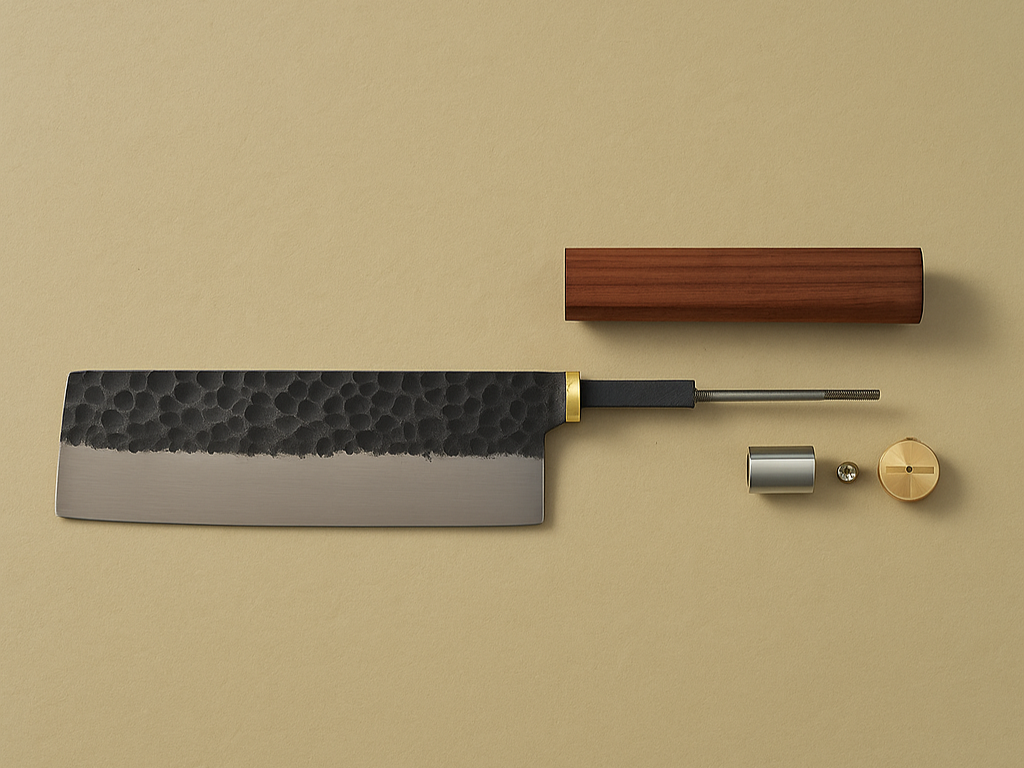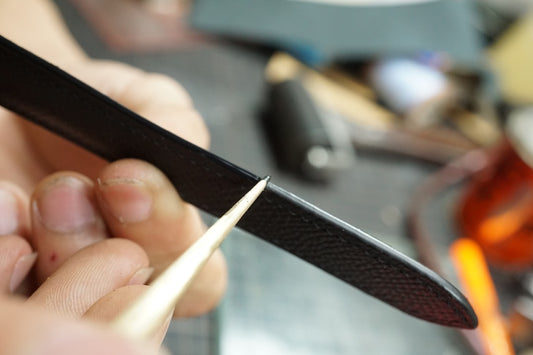
Share
Understanding Japanese Knife Anatomy: The Key to Superior Cutting Tools
Estimated reading time: 10 minutes
Key Takeaways
- Every part contributes to overall function and balance.
- Craftsmanship impacts sharpness, durability, and feel.
- Japanese knives are fine-tuned for diverse culinary needs.
Table of Contents
- Overview of Japanese Knife Anatomy
- Blade Anatomy: Components and Blade Grind Types in Japanese Knives
- Handle Styles: Wa-Style vs Yo-Style Knives
- Knife Handle Materials in Japan
- Blade Material – High-Carbon vs Stainless Japanese Knives
- Selecting the Right Knife Based on Anatomy
- Conclusion: Mastering Japanese Knife Anatomy for Better Cooking
- Frequently Asked Questions
Overview of Japanese Knife Anatomy
Japanese knife anatomy involves several essential components:
- Blade: The core of cutting performance.
- Handle: Directs control and comfort.
- Tang: Connects blade and handle for stability.
- Bolster: Offers balance and hand protection (not always present in traditional Japanese knives).
Each part of a Japanese kitchen knife is meticulously handcrafted by skilled artisans, often using techniques passed down through generations. This deep tradition ensures each knife is both beautiful and highly functional, with every element engineered for purposeful use.
Key Points:
- Every part contributes to overall function and balance.
- Craftsmanship impacts sharpness, durability, and feel.
- Japanese knives are fine-tuned for diverse culinary needs.
Learn more about Japanese knife anatomy | Anatomy of a Japanese knife, explained | Detailed part descriptions
Blade Anatomy: Components and Blade Grind Types in Japanese Knives
Understanding the different parts of the blade reveals why Japanese knives perform distinctively.
Key Parts of a Japanese Knife Blade
-
Tip (Kissaki):
- The pointed end, used for precise, intricate tasks like trimming or detailed scoring.
- Because it’s delicate, it’s often the first area to dull or chip, requiring careful attention.
-
Edge (Hasaki):
- The sharpened side running from heel to tip.
- Handles the majority of slicing and chopping.
- Edge quality defines sharpness and overall effectiveness.
-
Spine (Mune):
- The unsharpened upper side.
- Provides strength and helps with balancing the knife.
- A thicker spine can make the knife feel sturdier in hand.
-
Heel:
- The rear, lower section of the blade.
- Good for chopping through tough vegetables and proteins.
- Often used for forceful cuts.
-
Belly:
- The curved region between heel and tip.
- Important for rocking chopping motions.
- The amount of curve affects the style of cutting possible.
-
Choil (Ago):
- The corner or base of the blade, where edge meets handle.
- Influences comfort and where fingers naturally grip.
Keywords and Synonyms: blade tip, edge, spine, knife belly, choil, heel, Japanese blade parts
Schematic guide to blade parts | Comprehensive parts list | Visual explanations and terminology | Detailed part breakdown
Blade Grind Types in Japanese Knives
The “blade grind types Japanese knives” use impact sharpness, ease of use, and food compatibility.
-
Single-Bevel Grind:
- Sharpened on one side only (usually the right).
- Produces ultra-precise, thin slices.
- Ideal for specialized tasks, such as preparing sushi or sashimi.
- Requires skill to use and maintain.
- Left-handed versions are rare and more expensive.
- Japanese Chef Knife Types: A Comprehensive Guide to Choosing the Perfect Blade
-
Double-Bevel Grind:
- Sharpened on both sides.
- More versatile and easier to maintain.
- Handles a wider variety of kitchen tasks (vegetables, meats, fish).
- Preferred for all-purpose kitchen knives.
- Gyuto Knife Review: Comprehensive Guide to Japanese Knives and Their Unique Benefits
How Grind Types Affect Performance:
- Sharpness: Single-bevel achieves keener edge but is more delicate.
- Ease of Sharpening: Double-bevel easier for beginners.
- Suitability: Single-bevel for specialist work, double-bevel for generalist.
Further details and diagrams on blade grind types | Comprehensive overview of blade sections and grinds
Handle Styles: Wa-Style vs Yo-Style Knives
Handle design impacts comfort, balance, and user preference. The two main handle types in Japanese knives are Wa-style and Yo-style.
Wa-Style (Traditional Japanese Handles)
- Shape: Round, oval, D-shaped, or octagonal.
- Material: Most often lightweight wood (like magnolia, ho, or chestnut).
- Tang: Usually a partial (hidden) tang.
- Balance: Blade-forward for increased agility and quickness.
- Feel: Light in hand; preferred for intricate or rapid slicing.
- Tradition: Maintains classic Japanese design.
Yo-Style (Western Handles)
- Shape: Ergonomic, often contoured for grip.
- Material: Heavier woods, resin, or composite materials.
- Tang: Usually a full tang, visible along the spine.
- Features: Typically includes rivets for securing handle scales.
- Balance: Heavier, with more weight resting in the handle.
- Feel: Sturdy; familiar to those who grew up using Western chef’s knives.
Wa-style vs yo-style knives: The primary distinctions are tradition, grip feel, weight, and intended use. Wa-style is lighter and gives a nimble, blade-forward feel; Yo-style is heavier, offering durability and comfort for powerful chopping.
Ergonomic Implications
-
Wa-Style:
- Better for delicate, high-speed tasks.
- Good for smaller hands or those preferring agility.
-
Yo-Style:
- Delivers robust grip for forceful work.
- A comfort match for users switching from Western knives.
Suitability and Comfort
- Young cooks may favor the stability of Yo-style.
- Experienced users, especially in Japanese cuisine, may prefer the traditional touch of Wa-style handles for finesse.
Read more about handle styles and ergonomics
Knife Handle Materials in Japan
Selecting the right knife handle materials Japan is about balancing tradition, comfort, and modern-day needs.
Common Knife Handle Materials
-
Natural Wood:
- Magnolia (Ho Wood): Extremely light, shock-absorbent, commonly used for Wa handles.
- Rosewood/Ebony: Dense, richly hued wood for luxury feel; more expensive.
- Key Benefits: Warm, organic grip; aesthetically traditional.
- Drawbacks: Vulnerable to splitting and water absorption; requires periodic oiling.
-
Composite Materials:
- Examples: Pakkawood (wood resin mix), micarta, stabilized woods.
- Key Benefits: Durable, water-resistant, maintains hygiene.
- Drawbacks: May lack the authentic feel of pure wood.
-
Plastic and Resin:
- Examples: Polypropylene, ABS.
- Key Benefits: Highly durable, needs minimal maintenance, dishwasher-safe.
- Drawbacks: Less traditional look and feel.
Material Comparison Table:
| Material | Feel & Grip | Maintenance | Durability | Tradition | Hygiene |
|---|---|---|---|---|---|
| Magnolia | Warm, light | High | Medium | High | Low-Medium |
| Rosewood | Hard, dense | Medium | High | High | Medium |
| Pakkawood | Firm, smooth | Low | High | Medium | High |
| Resin/Plastic | Firm, cool | Low | Very high | Low | High |
Keywords and Synonyms: handle woods, knife handle types, Japanese knife handle choices, composite, resin, pakkawood, micarta, ABS
Explore Japanese knife handle materials
Blade Material – High-Carbon vs Stainless Japanese Knives
Choosing between high-carbon vs stainless Japanese knives means balancing sharpness, maintenance, and corrosion resistance.
High-Carbon Steel
- Sharpness: Exceptionally keen edge; easily honed.
- Edge Retention: Maintains sharpness longer with proper care.
- Feel: Precise, crisp cuts ideal for professionals.
- Vulnerability: Susceptible to rust, patina, and corrosion.
- Care Needs: Must be kept dry, regularly oiled, and washed by hand.
Stainless Steel
- Corrosion Resistance: Built to fight rust, staining, and discoloration.
- Maintenance: Lower upkeep; ideal for busy kitchens.
- Sharpness: Very sharp, though often less acute than high-carbon options.
- Durability: Handles diverse kitchen conditions.
- Feel: More forgiving; suitable for general use.
Impact on Longevity & Maintenance
- High-carbon knives: Suited for experts ready to invest time in care and maintenance routines.
- Stainless knives: Great for users wanting reliability with minimal fuss.
Which Steel Type Should You Choose?
- Professionals: Often choose high-carbon steel for peak sharpness.
- Home cooks or shared kitchens: Stainless steel for ease of maintenance and durability.
LSI and Related Terms: carbon steel, stainless cutlery, rust-resistant, oxidation, patina, knife edge retention
Selecting the Right Knife Based on Anatomy
Knowing Japanese knife anatomy makes it easier to choose a knife that fits your cooking needs and habits.
Practical Selection Guidelines
-
Identify Primary Tasks:
- Sushi, sashimi, or delicate produce: Opt for thin, single-bevel, high-carbon blades. Japanese Chef Knife Types: A Comprehensive Guide to Choosing the Perfect Blade
- General home cooking: Double-bevel, stainless steel for easy upkeep and versatility.
-
Consider Blade Grind and Material:
- Single-bevel blades for specialists or traditional Japanese cuisine.
- Double-bevel for multipurpose tasks and varied ingredients.
-
Choose Handle Style:
- Wa-style for control, comfort, and tradition.
- Yo-style for heft, sturdiness, and familiarity.
-
Handle Material:
- Traditional woods for classic feel and control.
- Composite or resin for modern kitchens needing durability and hygiene.
-
Think About Ergonomics and Hygiene:
- If you’ll use the knife daily or share it, handle comfort and easy sanitizing become vital.
Examples
Case 1: Sushi Chef
Prefers high-carbon steel, single-bevel blade, Wa-style handle (ideal for ultra-precise slicing of fish). Gyuto Knife Review: Comprehensive Guide to Japanese Knives and Their Unique Benefits
Case 2: Home Cook
Picks double-bevel, stainless steel, Yo-style handle (balanced, easy to maintain, can handle everything from vegetables to meat). Japanese Chef Knife Types: A Comprehensive Guide to Choosing the Perfect Blade
Conclusion: Mastering Japanese Knife Anatomy for Better Cooking
Understanding Japanese knife anatomy empowers you to make informed choices—transforming your experience in the kitchen. The right knife, built with the ideal blade grind, handle style, and material, elevates precision, comfort, and enjoyment in cooking.
Key Takeaways:
- Blade design, grind, and material define sharpness and longevity.
- Handle type and material affect grip, control, and maintenance needs.
- Selecting the appropriate knife for your tasks makes every cut easier and safer.
Next Steps:
- When shopping for Japanese knives, inspect the anatomy carefully.
- Consider your typical kitchen tasks and personal preferences.
- Maintain your blades and handles to preserve their quality and beauty over time.
Explore Further
Discover visual diagrams and deep-dive resources to enhance your understanding:
Enhance your knowledge with visual guides, infographics, and in-depth articles. The more you understand about Japanese knife anatomy, the more effective and enjoyable your kitchen work will become.
Images and Diagrams to Consider Including:
- Labeled diagram showing Japanese knife parts: tip, edge, spine, heel, belly, choil, tang, bolster, handle.
- Side-by-side comparison of Wa-style and Yo-style handles.
- Close-up of blade grind types (single vs double bevel).
For every culinary artist—whether just beginning or expertly crafting sushi—mastering Japanese knife anatomy unlocks precision, efficiency, and delight in every meal.
Frequently Asked Questions
What are the main parts of a Japanese knife?
The main parts include the blade (tip, edge, spine, heel, belly, choil), handle, tang, and sometimes a bolster.
What's the difference between Wa-style and Yo-style handles?
Wa-style handles are traditional Japanese handles, lighter and usually made from wood, while Yo-style are Western-style, heavier, and often made from composite materials.
Should I choose a high-carbon or stainless steel blade?
High-carbon steel offers superior sharpness but requires more maintenance. Stainless steel is more resistant to rust and easier to care for, making it suitable for everyday use.


